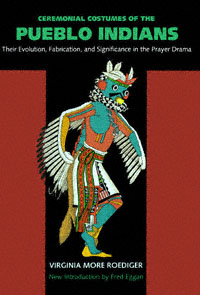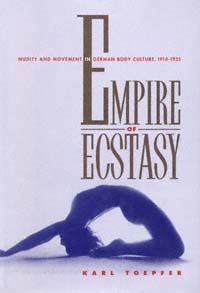formerly eScholarship Editions


|
|
|
|
Your search for
'Dance' in subject
found 2 book(s). | Modify Search | Displaying 1 - 2 of 2 book(s) | |
| 1. |  | Title: Ceremonial costumes of the Pueblo Indians: their evolution, fabrication, and significance in the prayer drama Author: Roediger, Virginia More Published: University of California Press, 1991 Subjects: Anthropology | Cultural Anthropology | Dance | Art Publisher's Description: When the University of California Press first published Roediger's Ceremonial Costumes of the Pueblo Indians in 1941, it was immediately hailed as both a beautiful book and the most comprehensive description ever of the making and meaning of the Pueblo costumes of New Mexico and Arizona. It has been widely acknowledged as a classic and eagerly sought after in antiquarian bookstores.Exactly fifty years after its original publication, here is the book back in print, with a new introduction by the renowned anthropologist Fred Eggan. Roediger's vivid paintings are reproduced once more in full color, capturing the beauty and drama of the Pueblo ceremonies - the turquoise dance moccasins, the tableted headdress of the Zuni corn maidens, the bright-blanketed Kachina maiden, and the buffalo, brilliant eagle, and horned deer costumes.It was Roediger who first viewed the ceremony and ritual of the Pueblo peoples as dramatic performance, a view that has gained great currency since. As a student of drama at Yale University she was fascinated by the intensely theatrical dimension to Pueblo worship, and it is this original perspective that informs and illuminates her study.After a brief survey of the history, location, and life of the Pueblo peoples, Roediger embarks on a thorough analysis of the materials used in the Pueblo costumes. She explains both their symbolic significance and their manufacture - from the weaving of cloth and the tanning of leather to the preparation of birds' feathers, evergreens, paints, and dyes. She then provides a meticulous description of the costumed dancer - body paint, garments, ornaments, accessories, and dance properties such as rattles, headdresses, and masks.In her final section, Roediger explores the relation of the costumes to the prayer dramas, particularly to the reverential, solemn, ecstatic public dance with which these climax. Vivid details emerge here about such rituals as the animal dances from the Rio Grande region and the Rain Dance of the Zuni.Fifty years after its original publication, Virginia Roediger's book remains the most comprehensive study of the ceremonial costumes of the Pueblo peoples. A book of great visual appeal and unrivaled detail, it will be welcomed back by scholars and general readers alike. [brief] Similar Items |
| 2. |  | Title: Empire of ecstasy: nudity and movement in German body culture, 1910-1935 Author: Toepfer, Karl Eric 1948- Published: University of California Press, 1997 Subjects: Cinema and Performance Arts | German Studies | Gender Studies | Dance Publisher's Description: Empire of Ecstasy offers a novel interpretation of the explosion of German body culture between the two wars - nudism and nude dancing, gymnastics and dance training, dance photography and criticism, and diverse genres of performance from solo dancing to mass movement choirs. Karl Toepfer presents this dynamic subject as a vital and historically unique construction of "modern identity." The modern body, radiating freedom and power, appeared to Weimar artists and intelligentsia to be the source of a transgressive energy, as well as the sign and manifestation of powerful, mysterious "inner" conditions. Toepfer shows how this view of the modern body sought to extend the aesthetic experience beyond the boundaries imposed by rationalized life and to transcend these limits in search of ecstasy. With the help of much unpublished or long-forgotten archival material (including many little-known photographs), he investigates the process of constructing an "empire" of appropriative impulses toward ecstasy. Toepfer presents the work of such well-known figures as Rudolf Laban, Mary Wigman, and Oskar Schlemmer, along with less-known but equally fascinating body culture practitioners. His book is certain to become required reading for historians of dance, body culture, and modernism. [brief] Similar Items |